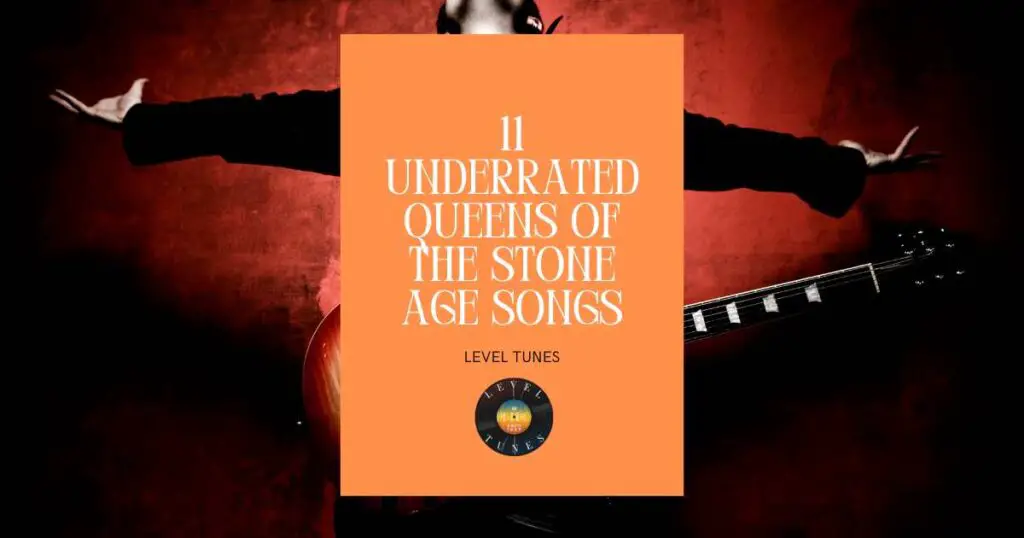11 Underrated Queens of the Stone Age Songs: Deep Cuts
Hey there, music aficionados! It’s TBone here, the beat-loving, tune-sharing DJ and proud owner of Level Tunes.
As a DJ and a die-hard music enthusiast, I’ve always had a special place in my heart for the gritty, raw sound of Queens of the Stone Age.
But today, I’m not here to talk about their chart-toppers. Instead, I’m diving into the hidden gems – those underrated tracks that don’t always make it to the mainstream playlists but deserve just as much spotlight. I’ve curated a list of 11 Queens of the Stone Age songs that have flown under the radar but are absolute masterpieces in their own right.
Why this list?
Because every song tells a story, and these tracks have tales that shouldn’t be left untold. Join me as we explore the lesser-known but equally captivating side of this iconic band.
Let’s get started!
Here are the underrated Queens of the Stone Age songs that you can check out:
List Of Underrated Queens of the Stone Age Songs
Underrated Queens of the Stone Age songs in a list format:
1. “I Think I Lost My Headache”
From the album “Rated R” (2000), released under Interscope Records, “I Think I Lost My Headache” is a testament to QOTSA’s ability to blend heavy, riff-based rock with a sense of eeriness. Written by Josh Homme, this track stands out for its hypnotic repetition and the surprising addition of a horn section towards the end, creating an almost surreal soundscape. The song’s outro, in particular, veers off into a jazzy, almost psychedelic territory, showcasing the band’s willingness to experiment. The reason for its inclusion here? It’s a perfect example of how QOTSA can bend genres while still maintaining their distinctive sound.
2. “Autopilot”
Featured on the album “Rated R” (2000), under Interscope Records, “Autopilot” is penned and sung by bassist Nick Oliveri. This track is a stark contrast to the album’s more aggressive songs, offering a laid-back, almost dreamy vibe. The song’s mellow tone, coupled with its introspective lyrics, makes it a unique piece in the QOTSA catalog. Oliveri’s vocal delivery adds a raw, unfiltered quality to the track, making it resonate on a different emotional level compared to Homme’s lead vocals. I chose this song for its ability to showcase the band’s versatility and Oliveri’s often-overlooked songwriting prowess.
3. “Mosquito Song”
The closing track of “Songs for the Deaf” (2002), released by Interscope Records, “Mosquito Song” is a departure from the album’s overall intensity. Written by Josh Homme, it’s an acoustic-driven piece, rich in imagery and storytelling. The inclusion of orchestral elements and haunting melodies creates a cinematic feel. The song is a hidden masterpiece, showcasing Homme’s songwriting skills and the band’s ability to create epic, story-driven compositions. Its inclusion here is to highlight the band’s range beyond their usual hard-rocking sound.
4. “In the Fade”
This track from “Rated R” (2000), under Interscope Records, features Mark Lanegan on lead vocals. Lanegan’s gravelly voice adds a depth and soulfulness to the song, setting it apart from the rest of the album. Written by Josh Homme and Nick Oliveri, the song’s introspective lyrics and melancholic melody create a mood that’s both reflective and haunting. The reason for its inclusion on this list is its showcase of Lanegan’s vocal prowess and the song’s emotive power, which often goes unnoticed.
5. “Tangled Up in Plaid”
From their album “Lullabies to Paralyze” (2005), released by Interscope Records, “Tangled Up in Plaid” is a Josh Homme creation that combines catchy riffs with intricate songwriting. The song features a driving rhythm section and Homme’s signature guitar work, creating a sound that’s both familiar and fresh. The lyrics are cryptic yet engaging, inviting listeners to dive deeper into their meaning. This song is included for its blend of classic QOTSA elements with a twist, showcasing their evolution as a band.
6. “I Was A Teenage Hand Model”
The closing track of their self-titled debut album “Queens of the Stone Age” (1998), released by Loosegroove Records, “I Was A Teenage Hand Model” is a quirky and experimental piece. Written by Josh Homme, it combines a piano-driven melody with an array of sound effects and spoken word segments, creating a uniquely eccentric composition. This track is a glimpse into the band’s early experimental phase and is included for its display of the band’s willingness to push musical boundaries.
7. “Better Living Through Chemistry”
Featured on “Rated R” (2000), this song, crafted by Josh Homme and Nick Oliveri, is a journey through different musical landscapes. Released under Interscope Records, it begins with a hypnotic, slow-building intro that explodes into a powerful riff-driven section. The dynamic shifts in this song are a testament to QOTSA’s musical mastery. I’ve included it for its epic scope and the way it encapsulates the band’s ability to create a musical rollercoaster.
8. “The Blood is Love”
From “Lullabies to Paralyze” (2005), released by Interscope Records, “The Blood is Love” is a dark, brooding track penned by Josh Homme. The song’s haunting melody and atmospheric sound make it stand out in the band’s discography. Its slow tempo and moody vibes contrast sharply with the more uptempo tracks on the album, showcasing the band’s diverse range. This song is included for its captivating mood and the way it demonstrates the band’s skill in creating deep, immersive tracks.
9. “Suture Up Your Future”
This track, from the album “Era Vulgaris” (2007), released by Interscope Records, is another Josh Homme masterpiece. It’s a reflective and somewhat melancholic song, featuring thoughtful lyrics and a softer, more melodic approach. The song’s introspective nature offers a different perspective on the band’s usually hard-hitting style. The inclusion of this song is to highlight the band’s ability to craft poignant, emotionally resonant songs.
10. “Hideaway”
From their album “Villains” (2017), released under Matador Records, “Hideaway” is a creation of Josh Homme that showcases the band’s evolution over the years. The track has a groovy, almost danceable rhythm, blended with their signature rock sound. It’s a testament to the band’s ability to adapt and evolve while maintaining their core musical identity. This song is included for its demonstration of QOTSA’s continual growth and willingness to explore new musical territories.
11. “Kalopsia”
Featured on “…Like Clockwork” (2013), released by Matador Records, “Kalopsia” is a collaboration between Josh Homme and Trent Reznor of Nine Inch Nails. The song is a hauntingly beautiful piece, combining eerie melodies with powerful dynamics. The term “kalopsia,” referring to seeing things more beautifully than they are, perfectly encapsulates the song’s ethereal and slightly surreal nature. This track is included for its artistic depth and the successful collaboration that adds a unique dimension to QOTSA’s sound.
Fun Facts: Underrated Queens of the Stone Age Songs
“I Think I Lost My Headache”
- Fact: The ending of “I Think I Lost My Headache” is notoriously different from the rest of the song. It features a brass section that seems almost out of place, creating a distinct and unusual closing for a rock track. This ending has been both praised and criticized for its abrupt shift in style.
“Autopilot”
- Fact: “Autopilot” was not only written but also sung by bassist Nick Oliveri. This song is one of the few QOTSA tracks where lead vocalist Josh Homme does not take the lead, showcasing Oliveri’s versatility and adding a different flavor to the band’s sound.
“Mosquito Song”
- Fact: Often considered a hidden gem, “Mosquito Song” features an array of acoustic instruments and orchestral arrangements, making it stand out from the rest of the “Songs for the Deaf” album. The song’s intricate composition has led fans to liken it to a modern-day rock opera piece.
“In the Fade”
- Fact: “In the Fade” features Mark Lanegan, known for his work with Screaming Trees, on lead vocals. His deep, gravelly voice adds a unique texture to the song, differentiating it from other tracks on the “Rated R” album. This collaboration is a fine example of QOTSA’s penchant for featuring distinct vocal talents in their music.
“Tangled Up in Plaid”
- Fact: The title “Tangled Up in Plaid” is a nod to the infamous flannel fashion associated with the grunge movement of the 90s. Despite being released in 2005, the song and its title reflect a certain nostalgia and acknowledgement of the era that significantly influenced Homme and the band.
“I Was A Teenage Hand Model”
- Fact: “I Was A Teenage Hand Model” is unique for its use of a variety of unconventional sound effects and its quirky outro, which includes a voicemail message. This experimental and somewhat eccentric approach showcases QOTSA’s willingness to push the boundaries of traditional rock music.
“Better Living Through Chemistry”
- Fact: The title “Better Living Through Chemistry” is a play on an old DuPont advertising slogan. The song itself is known for its psychedelic overtones and has been a staple in live performances, often extended with elaborate jam sessions that showcase the band’s improvisational skills.
“The Blood is Love”
- Fact: “The Blood is Love” is often praised for its atmospheric qualities, with fans and critics alike noting its cinematic sound. The song’s haunting melody and evocative lyrics suggest a deeper narrative, adding a layer of mystique to the album “Lullabies to Paralyze.”
“Suture Up Your Future”
- Fact: “Suture Up Your Future” stands out for its introspective and contemplative nature, a contrast to the typically hard-edged sound of QOTSA. The song’s more melodic and subdued approach highlights Homme’s versatility as a songwriter and the band’s ability to explore different emotional territories.
“Hideaway”
- Fact: “Hideaway” shows Queens of the Stone Age’s ability to adapt to different musical styles. The song’s danceable beat and catchy melody represent a departure from their usual heavy rock sound, demonstrating the band’s evolution and experimentation with new genres.
“Kalopsia”
- Fact: “Kalopsia” features a collaboration with Trent Reznor of Nine Inch Nails, adding a unique texture to the track. The term ‘kalopsia’, meaning the delusion of things being more beautiful than they are, perfectly encapsulates the song’s hauntingly beautiful and surreal atmosphere.
And there you have it, fellow music lovers! A journey through the lesser-known but equally mesmerizing world of Queens of the Stone Age. These songs, rich in depth and diversity, remind us why we cherish this band’s unique sound. Keep exploring, keep rocking, and never stop discovering hidden musical treasures.
Thanks for reading.
TBone




